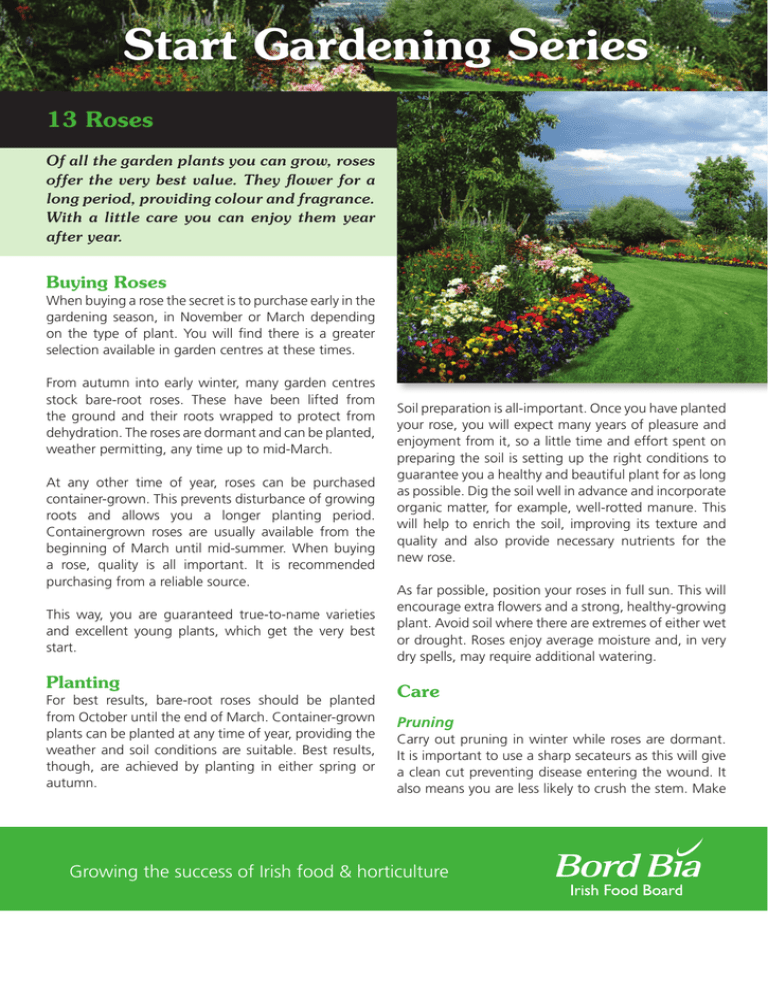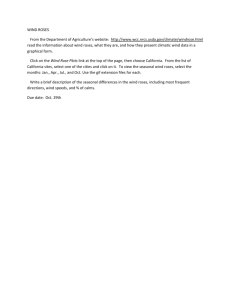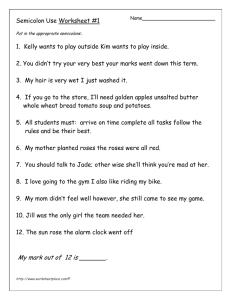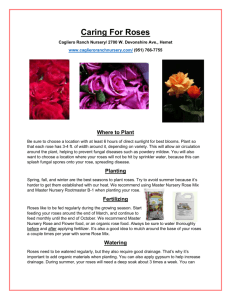Start Gardening Series 13 Roses
advertisement

Start Gardening Series 13 Roses Of all the garden plants you can grow, roses offer the very best value. They flower for a long period, providing colour and fragrance. With a little care you can enjoy them year after year. Buying Roses When buying a rose the secret is to purchase early in the gardening season, in November or March depending on the type of plant. You will find there is a greater selection available in garden centres at these times. From autumn into early winter, many garden centres stock bare-root roses. These have been lifted from the ground and their roots wrapped to protect from dehydration. The roses are dormant and can be planted, weather permitting, any time up to mid-March. At any other time of year, roses can be purchased container-grown. This prevents disturbance of growing roots and allows you a longer planting period. Containergrown roses are usually available from the beginning of March until mid-summer. When buying a rose, quality is all important. It is recommended purchasing from a reliable source. This way, you are guaranteed true-to-name varieties and excellent young plants, which get the very best start. Planting For best results, bare-root roses should be planted from October until the end of March. Container-grown plants can be planted at any time of year, providing the weather and soil conditions are suitable. Best results, though, are achieved by planting in either spring or autumn. Soil preparation is all-important. Once you have planted your rose, you will expect many years of pleasure and enjoyment from it, so a little time and effort spent on preparing the soil is setting up the right conditions to guarantee you a healthy and beautiful plant for as long as possible. Dig the soil well in advance and incorporate organic matter, for example, well-rotted manure. This will help to enrich the soil, improving its texture and quality and also provide necessary nutrients for the new rose. As far possible, position your roses in full sun. This will encourage extra flowers and a strong, healthy-growing plant. Avoid soil where there are extremes of either wet or drought. Roses enjoy average moisture and, in very dry spells, may require additional watering. Care Pruning Carry out pruning in winter while roses are dormant. It is important to use a sharp secateurs as this will give a clean cut preventing disease entering the wound. It also means you are less likely to crush the stem. Make Growing the success of Irish food & horticulture Start Gardening Series 13 Roses the cut approximately half a centimetre above a bud. Ideally this should be slightly sloping away to the back but not sloping below the bud itself. If possible, you should avoid leaving long snags above a bud as these will die back sometimes carrying dead growth down behind the bud which may damage new growth. When pruning, you should cut out all dead and diseased growth. Also, cut back all of last year’s growth to between 2 and 4 buds above the ground. Try to select outward-facing buds. This will encourage a more pleasing shape and helps avoid tangled stems. With climbing roses you will need to remove any stems growing in the wrong direction, but rather than cutting hard to the ground you will need to tidy the plant back to the wall. Dead-Heading Dead-heading roses is very important and by carrying out this practice you can guarantee yourself extra flowers. By removing the dead flowers, you are preventing energy going into developing seedheads. When the flowers have faded, cut the stem 3-4 leaves below the flower. This will ensure a new flowering shoot, which will bring you extra colour a little later. There is no need to remove dead flowers on roses which are grown for their decorative hips or roses which are only once-flowering. Feeding Roses provide a fantastic display and offer superb value for money. But to get the very best from your rose and to guarantee a healthy show of flowers, it is essential that you feed on a regular basis. Rose blossoms make a great demand on the plant and so supplementing with feeding ensures a good crop. The most popular rose feeds, which are widely available, are granular fertilisers. These contain a special blend of nutrients, including magnesium,which is very important to roses. This blend is specially formulated to give the rose everything it needs to perform well. These granular feeds should only be used while the rose is in active growth. They do not contribute to improving the soil but act quickly by feeding the rose. Liquid fertilisers are also available. These are an excellent choice for quick feeding. It is advisable to feed on a regular basis, following instructions. It is best to use little and often rather than apply one strong application. To improve the quality of soil and feed at the same time, it is a good idea to apply a mulch of well-rotted manure. This can be purchased pre-packed in garden centres. It is most beneficial when applied in autumn, allowing the winter weather time to work on it. Growing the success of Irish food & horticulture



